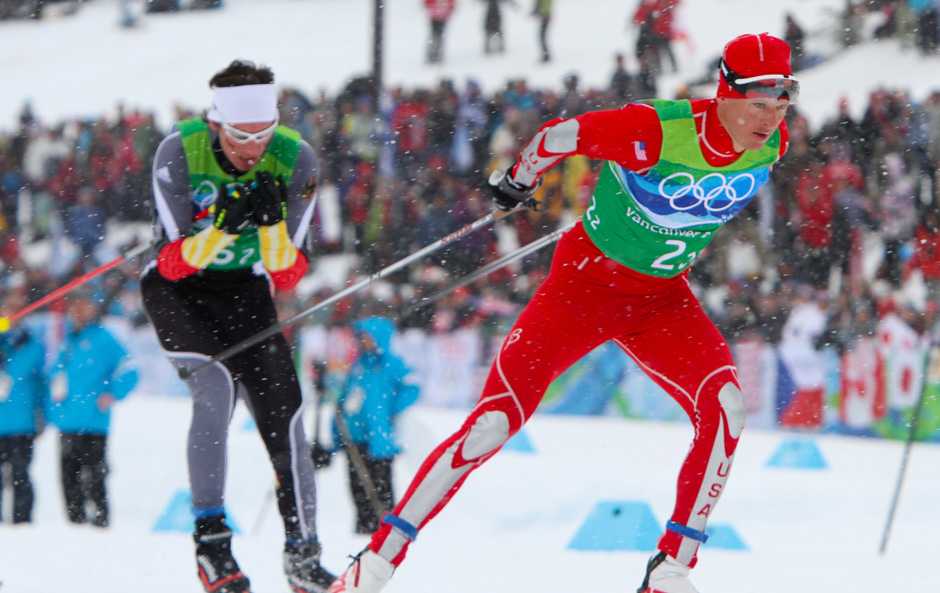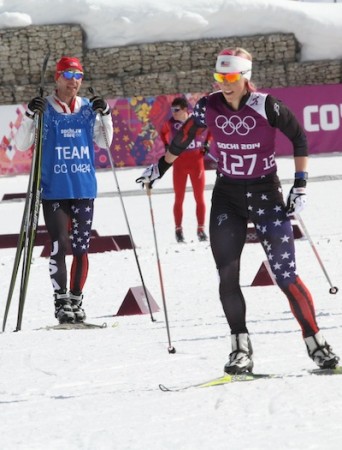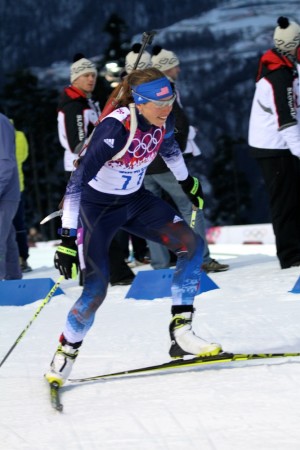
SOCHI, Russia – Before the Olympics, the NBC website put up a poll for the American public: who did they think should carry the United States flag at the opening ceremonies?
Bobsledder Chris Fogt topped the voting, with cross-country skier Kikkan Randall coming in second. But while it was a nice assessment of fan opinion, the poll had very little to do with the actual nomination process.
Todd Lodwick, a nordic combined skier making his sixth Olympic appearance, was eventually chosen for the honor.
“The election of the U.S. flag bearer is one of the few parts of the U.S. Olympic Team that remains private to the athletes,” said Brian Olsen, a former biathlete who is one of two main U.S. Olympic Committee Athlete Services Coordinators in Sochi.
He is in charge of the Endurance and Mountain Cluster athletes, and Jamie Hagerman oversees athletes in the Coastal Cluster. Together, they arranged a voting process so that the Olympic athletes themselves could choose who would lead them into Fisht Arena on opening night.
The first step in the process is nominating athletes to vote on.
“Any accredited athlete was welcome to nominate another athlete to carry the flag,” Olsen explained. “We did not impose a restriction on the number of nominees.”

Randall was nominated, although she wasn’t sure who had picked her. She described the feeling when she was called up and told the news.
“The support, goodwill and respect I’ve felt from my fellow Olympians this time around has been really special,” Randall wrote in an e-mail. “I think everyone understands the journey it’s taken for us in cross country to get to this level where we are actually contenders, and there is a pretty cool energy around the team being felt from so many realms. It’s great to finally see cross country getting more attention and consideration amongst the whole U.S. team!”
Next, all the nominees have to be contacted to see if they would actually be willing to do the job. Although Randall did not attend opening ceremonies as she felt the timing would disrupt her preparation for the actual racing coming up, she confirmed that if she’d been picked, she definitely would have gone.
“It was an incredible honor to be considered in the election for flag bearer,” she wrote. “If I had been elected to carry the flag I definitely would have gone down there.”
Not all the nominees were reachable, so a few were removed from the pool before voting even began.
Then, the voting itself.
“By tradition, each national governing body (NGB) received one vote in the election,” Olsen explained. “It was up to each NGB to select the athlete team representatives who were involved in the process, and which athlete team representative was to submit the ballot on behalf of all of its athletes.”
The biathlon team chose Susan Dunklee to represent them; the U.S. Ski and Snowboard Association (USSA) was not represented by a nordic athlete.
“It was the sort of thing where it was during the guys’ practice, so it was going to have to be one of us girls calling in,” Dunklee laughed. “They just asked me to do it.”
She sat down with her team and went over the list of nominees, and they discussed why or why not each athlete would be a good candidate before making a list of their favorites. Dunklee then rang in to a conference call set up by Olsen.
The athlete representatives listened to brief talks by the people who had nominated each of the possible flagbearers, and then got down to it. The voting was a ranked runoff process: each representative made a list of the order of their choices and e-mailed it in to Olsen and Hagerman, who then compiled the points and removed the lowest-ranked nominee before giving a new list to repeat the process. In the end, only Lodwick remained.

In between rounds, there was no lobbying on behalf of a favorite athlete. Dunklee said that the athlete representatives kept their votes secret throughout the whole process and did not discuss their reasoning with each other.
Dunklee said that she was happy with the process for two reasons: first, athlete input was taken into account, and second, the ranked process produced the candidate that most athletes agreed upon, although not all NGB’s showed up at the voting.
“A lot of countries, the Olympic organization just picks somebody,” Dunklee said. “But we have a very democratic process, which is cool… and it’s great that it’s the rank system. I think you have more of a consensus when you get to the end.”
Her one criticism of the system is that not all NGB’s are created equal. For instance, USSA comprises alpine skiing, freestyle skiing, snowboarding, cross country skiing, and nordic combined – many disciplines and many athletes who wouldn’t necessarily make the same choices.
She suggested that in the future, maybe voting could be done by sport rather than NGB.
“It seems so strange to me that USSA, when you have such a wide variety of sports represented, would only get one vote,” Dunklee said. “It seems like some of those sports wouldn’t get a voice at all. It would be interesting to see if that could be changed for future Games.”
Either way, this time it worked out for the nordic world. Lodwick was the fourth nordic athlete in history to carry the U.S. flag in opening ceremonies: cross country skier Rolf Monsen, originally from Norway, had the honor in 1936. There was a long break until biathlete Lyle Nelson carried the flag in 1988 and cross country skier Bill Koch in 1992.
“The American flag represents so much, so to be voted on by the athletes themselves was a true honor,” Lodwick told the Olympic News Service.
Chelsea Little
Chelsea Little is FasterSkier's Editor-At-Large. A former racer at Ford Sayre, Dartmouth College and the Craftsbury Green Racing Project, she is a PhD candidate in aquatic ecology in the @Altermatt_lab at Eawag, the Swiss Federal Institute of Aquatic Science and Technology in Zurich, Switzerland. You can follow her on twitter @ChelskiLittle.



